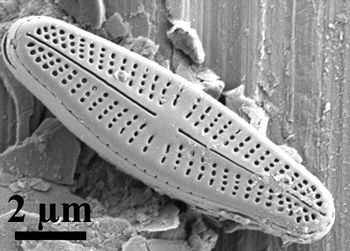Diatom: Difference between revisions
Jump to navigation
Jump to search

Pat Palmer (talk | contribs) mNo edit summary |
mNo edit summary |
||
| (2 intermediate revisions by one other user not shown) | |||
| Line 1: | Line 1: | ||
{{subpages}} | {{subpages}} | ||
{{Image|Achnanthidium minutissimum.jpeg|right|350px|Electron microscope photo of a 10-micron-long diatom, Achnanthidium minutissimum (Kützing) Czarnecki.}} | {{Image|Achnanthidium minutissimum.jpeg|right|350px|Electron microscope photo of a 10-micron-long diatom, Achnanthidium minutissimum (Kützing) Czarnecki.}} | ||
'''Diatom'''s are single-celled [[Algae|algae]] living in water, encased in tiny glass shells. | '''Diatom'''s are single-celled [[Algae|algae]] living in water, encased in tiny glass shells. Algae that are not diatoms are instead considered to be ''soft algae''. [[Phycology|Phycologists]] tend to specialize in one or the other, but not both. Likewise, phycologists tend to specialized in either freshwater or salt water algae, but not both. | ||
Diatoms are the bottom of the food chain. Since groundbreaking work by [[Ruth Patrick]] in the twentieth century, it is recognized that the mix of diatom populations in fresh water serves as a good indicator of the health of a body of water. Algae, including diatoms, account for nearly a quarter of the world's oxygen. | |||
The intricacy and symmetry of diatom fossils are renowned for their beauty<ref>[https://artsandculture.google.com/story/diatoms-of-the-academy-of-natural-sciences-of-drexel-university-academy-of-natural-sciences-of-drexel-university/BwWh7EaVlShRLw?hl=en Diatoms of the Academy of Natural Sciences of Drexel University] slideshow published online by Google. Last access 4/17/2022.</ref>. | The intricacy and symmetry of diatom fossils are renowned for their beauty<ref>[https://artsandculture.google.com/story/diatoms-of-the-academy-of-natural-sciences-of-drexel-university-academy-of-natural-sciences-of-drexel-university/BwWh7EaVlShRLw?hl=en Diatoms of the Academy of Natural Sciences of Drexel University] slideshow published online by Google. Last access 4/17/2022.</ref>. | ||
== Footnotes== | |||
<references> | |||
</references>[[Category:Suggestion Bot Tag]] | |||
Latest revision as of 07:00, 7 August 2024
Diatoms are single-celled algae living in water, encased in tiny glass shells. Algae that are not diatoms are instead considered to be soft algae. Phycologists tend to specialize in one or the other, but not both. Likewise, phycologists tend to specialized in either freshwater or salt water algae, but not both.
Diatoms are the bottom of the food chain. Since groundbreaking work by Ruth Patrick in the twentieth century, it is recognized that the mix of diatom populations in fresh water serves as a good indicator of the health of a body of water. Algae, including diatoms, account for nearly a quarter of the world's oxygen.
The intricacy and symmetry of diatom fossils are renowned for their beauty[1].
Footnotes
- ↑ Diatoms of the Academy of Natural Sciences of Drexel University slideshow published online by Google. Last access 4/17/2022.
